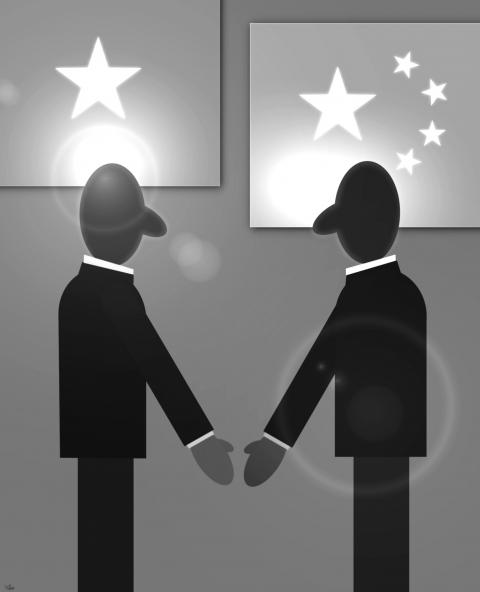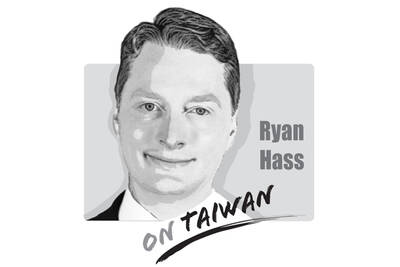One of the biggest beneficiaries of China’s rapid economic ascent is its historic rival, occasional enemy and fellow socialist neighbor to the south, Vietnam.
Less than a decade ago, many economists and executives thought that China’s rise would harm Vietnam economically.
Instead, Vietnam has managed to tag along, because of its own program of economic overhauls, a fast-growing population of 87 million people, cheap labor and a free-trade agreement that has enabled Vietnam to become part of the vast global supply chain that feeds China’s manufacturing machine.

Illustration: YUSHA
After following China down the path toward communism after World War II, Vietnam finds itself back in China’s ideological slipstream. This time, the government of Vietnam is driving toward what its calls a “-socialist-oriented market economy,” largely to keep from being run over by China’s economic juggernaut.
“If China had not been there, Vietnam may not have opened up,” said Jonathan Anderson, an economist at UBS in Hong Kong
Vietnam officially reopened its doors to foreign investors in 1986, but it did not truly become part of the Asian economic boom until it won back its former enemy, the US, which lifted a trade embargo in 1994 and normalized trade in 2000.
The US trade agreement provided special incentives to textile and garment makers because it immediately cut tariffs on brassieres and panties made in Vietnam to zero from about 60 percent. Textile and garment makers from Taiwan and South Korea flocked to Vietnam to open factories.
Other light manufacturing soon followed, like home appliances and motorbike assemblers, and another industry hitherto dominated by China, furniture.
“That whole industry just gradually moved into Vietnam,” said Frederick Burke, a lawyer at Baker & McKenzie in Ho Chi Minh City, formerly Saigon, who has been working in Vietnam and advising its government for more than a decade.
When China joined the WTO in 2002, however, many feared that Vietnam’s and much of Southeast Asia’s days as a favored destination for manufacturing investment were over. Some economists even warned that the region would have to surrender development led by the export of manufactured goods and instead focus on feeding China’s voracious demand for raw materials.
China signed a free-trade agreement with Vietnam and the nine other ASEAN members in 2002 that seemed to reinforce such fears. While the agreement gave poorer nations like Vietnam until 2015 to open up to Chinese goods, China eliminated tariffs on their agricultural products in 2003.
The agreement was a boon for Vietnam, which aside from being a leading exporter of rice, pepper and coffee, is a net oil exporter. However, as other nations like Singapore, Malaysia and Thailand scrambled to climb the value-added ladder with niche products or more advanced products to at least stay in the race with China, Vietnam seemed destined to become a pantry for a rapidly developing China.
Then China stumbled. Rampant technological piracy, nationalist demonstrations and shortages of skilled labor prompted many foreign companies, particularly those in Japan, to move some production back to Southeast Asia.
Worse, wages in China were rising fast.
“In the late 1990s and early 2000s, you could hire as much labor as you wanted in China. People now talk about rising labor costs,” Anderson said.
Waiting with its own well-educated, disciplined, but much cheaper work force, was Vietnam. The minimum wage in Vietnam’s two largest cities is still about US$75 a month, as little as half what it costs to hire a worker in China’s factory province of Guangdong, according to Dinh Tuan Viet, senior economist at the World Bank in Hanoi.
This year, Intel opened a US$1 billion semiconductor factory near Ho Chi Minh City to replace plants in Malaysia, the Philippines and China. Canon’s printer factory near Hanoi, with more than 18,000 employees, is the company’s largest.
Vietnam has now managed to establish itself firmly in China’s supply chain. Many of the parts for Canon’s factory come from China, for example, a fact that underscores the downside to Vietnamese efforts to follow in China’s manufacturing footsteps — imports of machinery and equipment from China contribute to a trade deficit of about US$11.5 billion with that country.
Now, with China trying to take its next major leap forward into cleaner, more consumer-focused industries, the question is whether Vietnam has developed enough to advance in step with China, Viet said.
“Is Vietnam ready and capable of absorbing a new wave of foreign investment resulting from ‘structural change’ in China?” he asked. “It seems to me there are still a lot of constraints for Vietnam to take this chance: poor infrastructure and an underdeveloped logistics industry, an abundant, but unskilled labor force, etc.”
For all of China’s many obstacles, Vietnam still ranks below it in the World Bank’s survey on the ease of doing business.
That survey ranks Vietnam above China in starting a business and employing workers, but below China in protecting investors and enforcing contracts. Vietnam also ranks low on Transparency International’s Corruption Perceptions Index — 116th, compared with 78th for China.
Still, Vietnam seems to have won favor as an alternative to China for foreign investors. Foreign direct investment in Vietnam rose almost fourfold from 2005 to 2008, according to the World Bank, to US$9.58 billion, and slipped 20 percent during the crisis in 2009 to US$7.6 billion. In China it almost halved.

China has not been a top-tier issue for much of the second Trump administration. Instead, Trump has focused considerable energy on Ukraine, Israel, Iran, and defending America’s borders. At home, Trump has been busy passing an overhaul to America’s tax system, deporting unlawful immigrants, and targeting his political enemies. More recently, he has been consumed by the fallout of a political scandal involving his past relationship with a disgraced sex offender. When the administration has focused on China, there has not been a consistent throughline in its approach or its public statements. This lack of overarching narrative likely reflects a combination
Father’s Day, as celebrated around the world, has its roots in the early 20th century US. In 1910, the state of Washington marked the world’s first official Father’s Day. Later, in 1972, then-US president Richard Nixon signed a proclamation establishing the third Sunday of June as a national holiday honoring fathers. Many countries have since followed suit, adopting the same date. In Taiwan, the celebration takes a different form — both in timing and meaning. Taiwan’s Father’s Day falls on Aug. 8, a date chosen not for historical events, but for the beauty of language. In Mandarin, “eight eight” is pronounced
US President Donald Trump’s alleged request that Taiwanese President William Lai (賴清德) not stop in New York while traveling to three of Taiwan’s diplomatic allies, after his administration also rescheduled a visit to Washington by the minister of national defense, sets an unwise precedent and risks locking the US into a trajectory of either direct conflict with the People’s Republic of China (PRC) or capitulation to it over Taiwan. Taiwanese authorities have said that no plans to request a stopover in the US had been submitted to Washington, but Trump shared a direct call with Chinese President Xi Jinping (習近平)
It is difficult to think of an issue that has monopolized political commentary as intensely as the recall movement and the autopsy of the July 26 failures. These commentaries have come from diverse sources within Taiwan and abroad, from local Taiwanese members of the public and academics, foreign academics resident in Taiwan, and overseas Taiwanese working in US universities. There is a lack of consensus that Taiwan’s democracy is either dying in ashes or has become a phoenix rising from the ashes, nurtured into existence by civic groups and rational voters. There are narratives of extreme polarization and an alarming